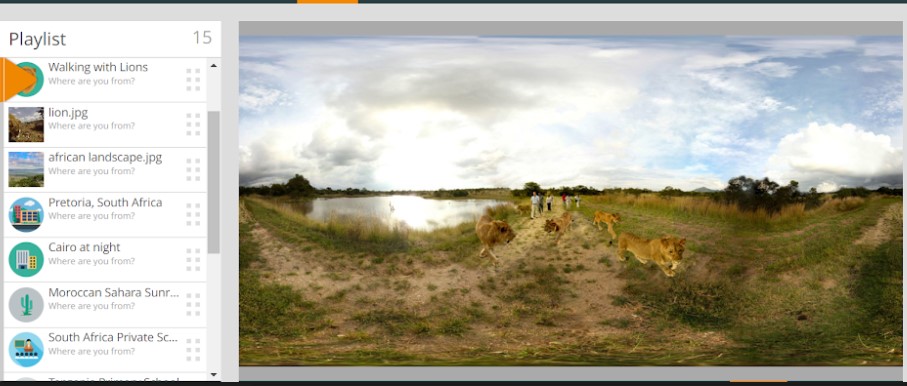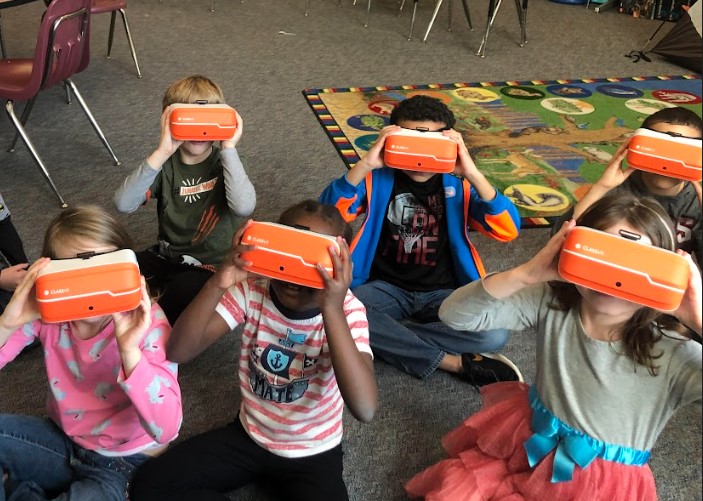Field trips are incredible learning opportunities for students, but options can sometimes be limited due to location, cost or other factors. For many schools, taking students on virtual field trips can be a great alternative to in-person experiences. Teachers can leverage virtual reality technology to help students have the feeling of being there as they explore places in their own communities, as well as farther-away locations like the Amazon rainforest or the pyramids of Egypt.

As the instructional technology resource educator who teaches computer science for Salem City Schools in Virginia, I help teachers use technology to support their lessons. We’ve found some great ways to leverage the power of virtual reality for amazing — sometimes even out-of-this-world — experiences to take classroom lessons to the next level. These virtual field trips engage students on a deeper level with the content while allowing them to experience new environments without leaving the classroom.
Here are a few ideas for virtual field trips that we’ve done at Salem City Schools, along with some strategies we’ve learned along the way.
Lesson 1: Touring students’ home countries

Many of our students are from other countries and are English language learners. Our third-grade teachers were looking for ways to support inclusivity for these students, so we created a virtual field trip to the students’ home countries.
For instance, one student is from Africa. We used virtual reality headsets and 360-degree images to help students experience the African savannah. They virtually explore it and have conversations with the student who was from that area about what it was like to live there. We can visit cities and landmarks this way too.
For our foreign students to have imagery from their home countries is powerful and helps them feel included and seen. It was one of the greatest instructional moments I’ve ever had.
Other options to supplement this lesson could be to have students bring in foods from their home countries or to create collages about their home countries during computer science class.
Lesson 2: The rainforest experience

This lesson teaches elementary-school students about the rainforest. Our district has ClassVR headsets, so I built a playlist on the accompanying website. Students put on their headsets, and I guide them through the 360-degree images and videos of a rainforest as I ask them questions about what they are experiencing. It’s really fun for them, and they feel like they’re there in the rainforest.
Previously teachers might have introduced students to the rainforest by rolling a video cart into the room, which is very abstract. With VR technology, you really feel like you are there, and wearing the headsets makes students feel like they’re on the cutting edge of technology.
For this lesson we spend 15 minutes with the headsets and then use other tools like Jamboard, Google Slides or Google Docs to share facts about the rainforest. Students are hitting that core content, experiencing new environments and having a lot of fun.
Lesson #3: Solar systems
For our out-of-this-world field trip, we (virtually) took our kids to visit planets so we could, at our teachers’ request, use VR to support their lessons about the solar system. We created a kindergarten through second-grade lesson and a third- through fifth-grade lesson for them.
For the K-2 lesson we used our VR headsets and an augmented reality cube. When students looked at the cube using the headsets, it became a planet. Students could get up close to it and walk around it to view the planet at different angles. After the AR experience, students completed a coloring sheet to show what the planet looked like and to describe it.
For the older students’ lesson, they used Jamboard to create a solar system by inserting images of planets in the correct order from images they found on Google. We’re adding to the lesson this year by having students use the VR headsets to explore the planets.
VR for special needs students
I taught special education for seven years. Those were very important days for me, and I learned so much about reaching students who have diverse learning needs. Virtual field trips are amazing for this.
Many of our students with special needs are already really good at using VR technology, and when we team them up with general education students, they become the experts. The general education students look to them for guidance and to answer questions, which is really rewarding.
VR experiences are also a good tool to help students focus. For instance, if a student is having difficulty managing their emotions, I can send them on a virtual vacation to the beach to get them calm and ready to learn.
Success strategies for virtual field trips:
Here are some specific strategies to get the most out of these experiences:
- Plan the right kind of field trip. Make sure it’s something that will really enhance the lesson. Teachers have lots of ideas, but you have VRto find the sweet spot that allows you to access video and photos and the right content to support the specific lesson.
- Start small. Little successes build into big ones. This is especially important if you’re implementing new technology that students haven’t used before. Download one experience with one image that’s going to blow students’ minds. Get through that before you try to do a more complex experience. If you try to bite off too much, it might overwhelm students, and you won’t be as successful.
- Be prepared for technology challenges. Some days the Wi-Fi might drop or something else won’t work. You have to be able to roll with that. When using VR headsets, download the lesson onto the devices ahead of time in case to avoid technical issues that would stop a live lesson from working.
Teachers can definitely find some creative ways to teach content in the classroom without using virtual field trips. But these opportunities help a lesson hit home because students aren’t just reading about the topic; they’re experiencing it. Helping students experience things virtually that they can’t see in person, such as a rainforest, a different country or another planet, adds a whole new level of engagement. As the experience begins, I literally hear students say, “Whoa!” at the same time.
I can’t overstate how important that engagement is. Getting — and keeping — students’ attention is invaluable. If they’re not engaged, it’s so much harder to teach them. Incorporating VR and AR technology for virtual field trips captures students’ attention every time, which makes all the difference.
Branden Wells is the instructional technology resource teacher for Salem City Schools in Virginia. He helps teachers incorporate technology into their classrooms, including using ClassVR from Avantis Education for virtual field trips.
Opinions expressed by SmartBrief contributors are their own.
_________________________
Subscribe to SmartBrief’s FREE email newsletter to see the latest hot topics on EdTech. It’s among SmartBrief’s more than 250 industry-focused newsletters.
